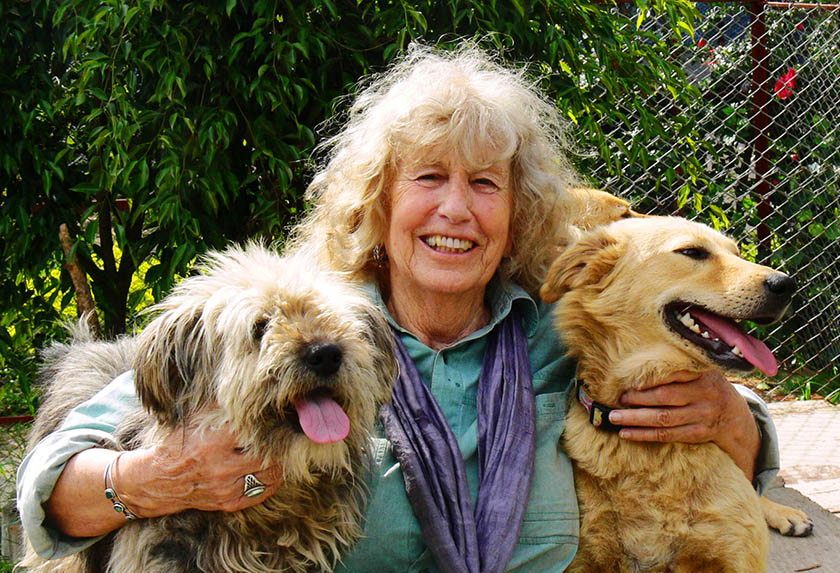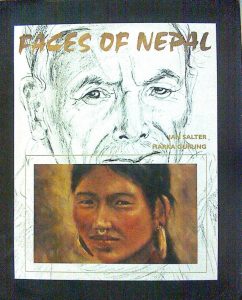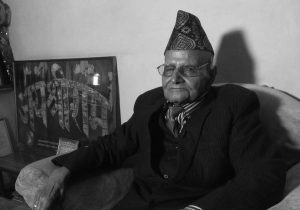
When I was growing up, I always saw her playing with dogs in her home. She had rented my grandfather’s brother’s place in Gairidhara of Kathmandu for nearly two decades, and all I knew about her was that she was a British lady who was ‘strict’. I also knew that she was a ‘good’ artist.
As a dog lover myself, I had always wanted to talk to her, but her grey hair and wrinkled face always frightened me and her strict persona made me wonder if she would talk to a kid like me.
A few years ago due to her deteriorating health, she decided to move back to the UK and today as news broke that Jan Salter passed away yesterday at her home in Lyme Regis in the UK aged 82, a certain regret started to creep in. All these years she lived close to my house, yet I knew so little about this lady who was not only a great artist but also an avid social worker who had always wanted to do good for the society.
Salter first visited Nepal in 1968 as part of her world tour and fell in love with it like many others. She initially worked as a hairdresser at Boris Lissanevitch’s Royal Hotel (now Yak and Yeti). But soon continued her journey to travel the world.
Having seen so little of Nepal, she returned in 1975 to experience more of the Himalayan Kingdom because she knew there was much more to explore here. She decided to stay and slowly trekked around the country. In the 80s, she visited an art show by the great Indonesian artist Affandi who told Salter that she could be more than an average painter and that drove her forward to paint and sketch more of what she saw in Nepal. The book she published with the help of the late Harka Gurung is a proof of that.

Faces of Nepal is more than a book. It shows the diversity of the people living in Nepal. It gives Nepalis a reason to be proud. Without her book, many in Nepal would not have known the extent of the diversity within their own country.
And that is not all that she was famous her. Her most notable work changed the lives of the thousands of street dogs in Nepal. When she realised that the street dogs were being killed by the municipalities, she decided to take a stand against the use of strychnine poison. She gave municipalities an example of Jaipur of India, a city which was able to deal with its stray dog population without poisoning them.
Slater also established the Kathmandu Animal Training (KAT) Centre. She came up with a plan to implement ABC (animal birth control) to stop the population of street dogs from multiplying. “In a way, it’s like family planning to dogs,” she joked in an interview.
“She didn’t do it for only the dogs, but also for the people in the community. She felt what the people were doing was inhumane and that people needed to stop doing that as it would also affect their own lives because if they cared for dogs they would care for people too,” says Kanak Mani Dixit, who knew Salter while working with her in the 90s.
During her time here in Nepal she never looked for recognition or applause for her work. She just got about it did her work the way she knew how to. People close to her say that she was self-confident and always worked at what she wanted to do. There was no stopping her.
But for the last eight years, she was fighting with Parkinson’s disease–a reason why she stopped painting. But that gave her an extra ounce of motivation to work at providing proper care for dogs through KAT Centre.
“She wasn’t just emotional, she always had a plan–a scientific and practical way of doing things,” adds Dixit.
To some, she was an artist, someone who changed the art scene in Nepal. To many, she was a social worker whose efforts paved way for dog safety in Nepal. She was a genuine human being who always wanted to do good for the society.
But to me, she was the old lady across the road whom I will never get to have talk to.
You can leave your message on a website dedicated to her.
RIP
























